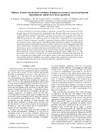Please use this identifier to cite or link to this item:
http://hdl.handle.net/10553/36016
| Title: | Influence of atomic kinetics in the simulation of plasma microscopic properties and thermal instabilities for radiative bow shock experiments | Authors: | Espinosa, G. Rodríguez, R. Gil, J. M. Suzuki-Vidal, F. Lebedev, S. V. Ciardi, A. Rubiano, J. G. Martel Escobar, Pablo |
UNESCO Clasification: | 22 Física | Keywords: | Optically Thin Laboratory Astrophysics Z-Pinches Gas Waves, et al |
Issue Date: | 2017 | Project: | Desarrollo de Modelos Físicos y Su Integración Computacional Para la Descripción Microscópica de Plasmas de Alta Densidad de Energía Implementation of activities described in the Roadmap to Fusion during Horizon 2020 through a Joint programme of the members of the EUROfusion consortium Eurofusión AWP15-ENR-01/CEA-02 |
Journal: | Physical review. E | Abstract: | Numerical simulations of laboratory astrophysics experiments on plasma flows require plasma microscopic properties that are obtained by means of an atomic kinetic model. This fact implies a careful choice of the most suitable model for the experiment under analysis. Otherwise, the calculations could lead to inaccurate results and inappropriate conclusions. First, a study of the validity of the local thermodynamic equilibrium in the calculation of the average ionization, mean radiative properties, and cooling times of argon plasmas in a range of plasma conditions of interest in laboratory astrophysics experiments on radiative shocks is performed in this work. In the second part, we have made an analysis of the influence of the atomic kinetic model used to calculate plasma microscopic properties of experiments carried out on MAGPIE on radiative bow shocks propagating in argon. The models considered were developed assuming both local and nonlocal thermodynamic equilibrium and, for the latter situation, we have considered in the kinetic model different effects such as external radiation field and plasma mixture. The microscopic properties studied were the average ionization, the charge state distributions, the monochromatic opacities and emissivities, the Planck mean opacity, and the radiative power loss. The microscopic study was made as a postprocess of a radiative-hydrodynamic simulation of the experiment. We have also performed a theoretical analysis of the influence of these atomic kinetic models in the criteria for the onset possibility of thermal instabilities due to radiative cooling in those experiments in which small structures were experimentally observed in the bow shock that could be due to this kind of instability | URI: | http://hdl.handle.net/10553/36016 | ISSN: | 2470-0045 | DOI: | 10.1103/PhysRevE.95.033201 | Source: | Physical Review E [ISSN 2470-0045], v. 95 (3), (033201) |
| Appears in Collections: | Artículos |
SCOPUSTM
Citations
13
checked on May 26, 2024
WEB OF SCIENCETM
Citations
13
checked on May 26, 2024
Page view(s)
134
checked on Mar 16, 2024
Download(s)
129
checked on Mar 16, 2024
Google ScholarTM
Check
Altmetric
Share
Export metadata
Items in accedaCRIS are protected by copyright, with all rights reserved, unless otherwise indicated.
